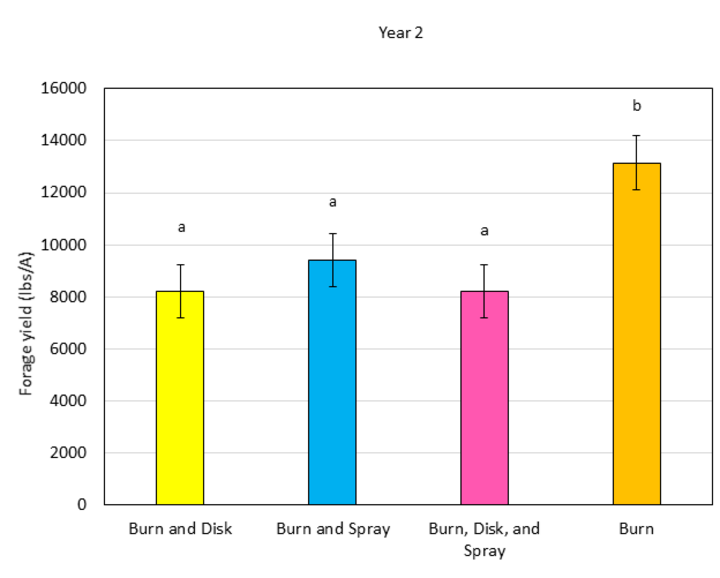Major Findings
- Legume establishment was not successful in five-year old big bluestem pastures.
- No management practices to increase legume introduction in established pastures were identified.
- Forage yields were highest with burning only, but never lower than disking or spraying.
- Minimal changes in forage quality were observed.
Why is This Important?


Big bluestem (Andropogon gerardii Vitman.) is a native, perennial grass, grown throughout most of the US for grazing and hay. Burning, herbicide application, and disking are all common management practices that have been used to reduce weed growth and encourage forage production. Equally, these management tools should offer improvements for establishing native legumes in perennial grass pastures by reducing competition and increasing seed-to-soil contact to increase plant diversity and reduce N fertilizer requirements.
Burning can be a useful tool for decreasing competition, removing plant litter, and nutrient cycling, and in big bluestem pastures.
Burning, when timed correctly, is the preferred method to increase yield and forage quality in big bluestem. Herbicide treatments have been used successfully to enhance the pastures and yield of warm-season grasses, particularly those with weed encroachment. Disking is another practice that has been used to enhance forage production, primarily when interseeding legumes into established grass pastures.
What Did We Do?
A two-year study was conducted to evaluate establishment of two native legume species into five-year old established big bluestem pastures. Treatment comparisons included burning, disking, application of a reduced rate of glyphosate (N-(phosphonomethyl)glycine), burning plus disking, burning plus glyphosate application, burning plus disking plus glyphosate application, and a non-treated control.
Annual burns were conducted in April of both years and disking and glyphosate treatments were applied in May of both years. ‘Kanoka’ roundhead lespedeza (Lespedeza capitata Michx.) and Illinois bundleflower (Desmanthus illinoensis Michx. Macm.) were either broadcast- or drill-seeded into established big bluestem pastures after all treatments were applied. No fertilizer was applied. Forage yield was collected at the end of the growing season, and nutritive value was measured using near-infrared reflectance spectroscopy.


Figure 4. Burning and disking, burning and spraying, burning, disking, and spraying, and burning effects on big bluestem forage yield in years 1 and 2.
What Did We Learn?
Legume establishment was not successful regardless of disturbance type or seeding method in well-established big bluestem pastures. Prescribed burning produced the greatest big bluestem forage yields. The herbicide and disking treatments did not increase forage yield or nutritive value compared with burning alone.
Forage yield was not different for any treatment during year 1 of the study. Big bluestem forage yield in year 1 averaged over 12,000 lbs/acre regardless of treatment. However, during year 2, burning produced the greatest forage yield. Burning alone produced 13,000 lbs/acre of big bluestem forage in year 2. The burning and disking, burning and herbicide, and herbicide treatments were similar with forage yields slightly greater than 8,600 lbs/acre. Based on these results, an appropriately timed prescribed burn is recommended to enhance big bluestem growth, since it is a cost-effective approach for weed suppression and increased forage production. Previous studies support this observation. However, nearly all other comparisons were to burned or non-burned treatments.
This study provided little evidence of nutritive value differences based on treatment. Neither crude protein (CP) nor in vitro dry matter digestibility (IVDMD) was affected by treatment type or legume seeding methods. Previous studies support this conclusion although most evaluations were to burned and non-burned comparisons.
So What?
Overall, establishment of legumes into productive big bluestem pasture continues to be difficult. Based on these results, prescribed burning, disking, and applying herbicides in the spring do not enhance legume establishment into big bluestem pasture. Additional treatments such as grazing or haying may be necessary during summer to reduce big bluestem competition and give legumes an opportunity to compete. The results of this study suggest applying a prescribed burn in April is the best practice to enhance big bluestem forage yield.
For more information on big bluestem and warm season forage production, please see http://extensionpublications.unl.edu/assets/pdf/g1908.pdf.
References
Allen, L. J., L.H. Harbers, R.R. Schalles, C.E. Owensby, and E.F. Smith. 1976. Range burning and fertilizing related to nutritive value of bluestem grass. Journal of Range Management 29 (4):306–308.
Peet, M., R. Anderson, and M.S. Adams. 1975. Effect of fire on big bluestem production. The American Midland Naturalist 94 (1):15–26.
Waller, S. S., and D.K. Schmidt. 1983. Improvement of astern Nebraska tallgrass range using atrazine or glyphosate. Journal of Range Management 36 (1):87–90.
Mitchell, R.B., and B.E. Anderson, 2008. Switchgrass, big bluestem, and indiangrass for grazing and hay. NebGuide G1908. Nebraska Extension. University of Nebraska, Lincoln, Nebr.
Mitchell, R.B., K.P. Vogel, T. Klopfenstein, B. Anderson, and R. Masters. Grazing evaluation of big bluestems bred for improved forage yield and digestibility. Crop Science 45:2288-2292. 2005.
About the Author
Kallie Calus was one of nine undergraduate students completing an Integrated Agronomic Systems Fellowship at the University of Nebraska-Lincoln in summer 2018. She is a senior at College of the Ozarks and will graduate in May 2019. She plans to attend the University of Nebraska and pursue an M.S. degree in the Department of Animal Science.
Acknowledgement
Support for this project was provided by a grant from the USDA NIFA FY15 Agriculture and Food Research Initiative: Education and Literacy Initiative-Undergraduate Experiential Learning Fellowships Program “Developing Research and Extension Skills of Students in Integrated Agronomic Systems.

